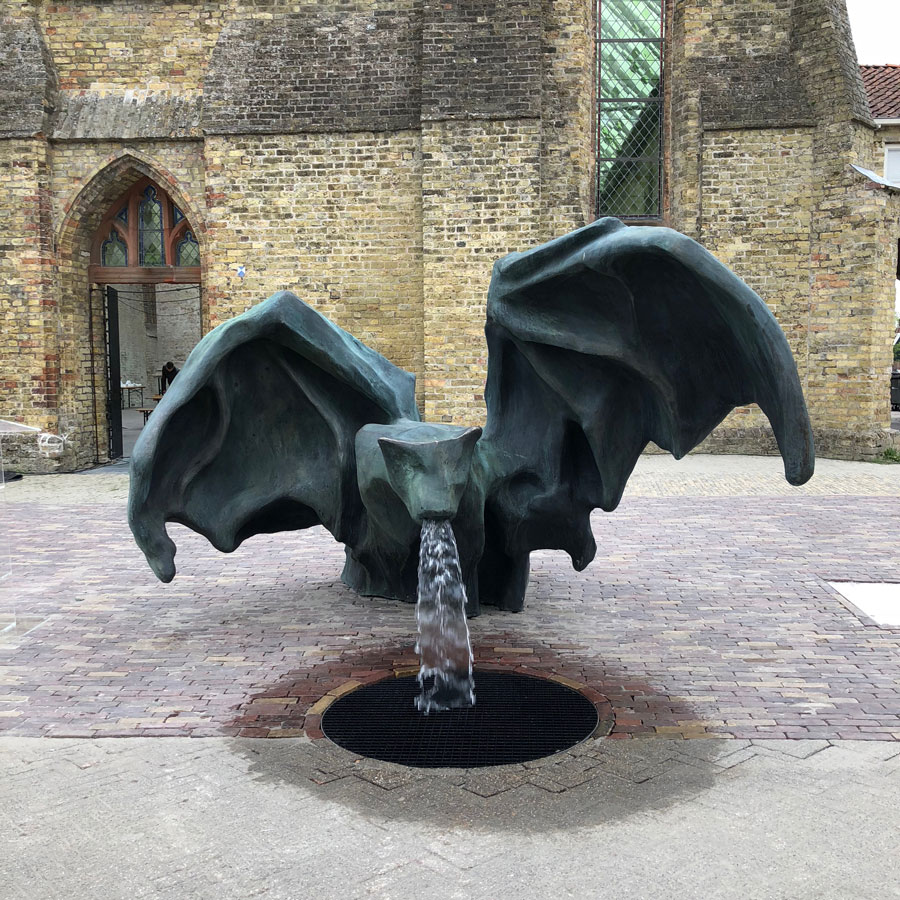zandpoortvest 10
be 2800 mechelen
t +32 15 336 336
m (b) +32 478 811 441
m (d) +32 475 477 478
Johan Creten: selected works
The Herring, 2018
bronze, lost wax casting with 'Pompeian patina', ed 1/1 AP of an edition 5 + 1 AP, P, 154 x 50 x 43 cm
Casting stamp, eagle stamp, signed, dated and numbered.
After a model in glazed stoneware.
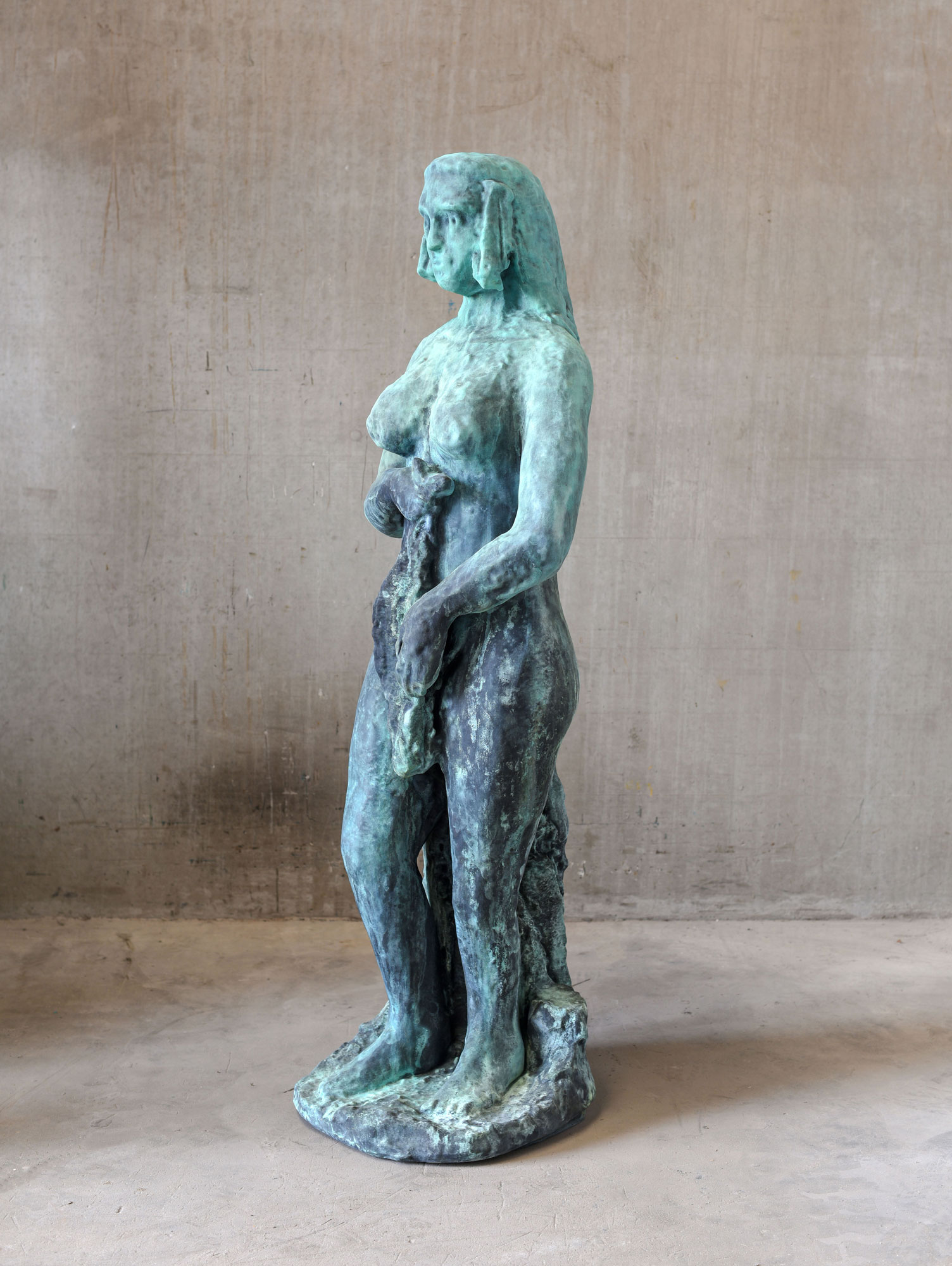
Silence itself is a pinnacle and, better yet, the holy of holies.
[Georges Bataille]
The bronze sculpture The Herring by artist Johan Creten (b. 1963) depicts a naked female figure. The woman stands in counter-posture, slightly leaning back, in a pose suggesting movement, yet the sculpture also evokes stillness in the viewer. Frozen immovably, capturing the silence of the moment, she stares out in front of her, her gaze almost bewildered and penetrating. She covers her sex with a fish.
Both the fish and the female figure are recurring elements in the artist's oeuvre.
The sculpture was first realised in glazed stoneware; a later, six-meter high version in painted polyester was presented at the Museum Beelden aan Zee in The Hague. The present version in bronze is one further step in the sculptor's search for the most appropriate form of expression best suited to articulate a multi-layered story. Historical and iconographic meanings unfold through the formal language, aesthetics and materiality of the work, together with a contemporary political dimension in which questions about religion and the relationship between man and nature are silently brought to the fore.
The relationship with classical antiquity is evidenced through the context of the work. Originally, the ceramic sculpture was part of the 8 Gods series that was first presented at Almine Rech (Brussels, 2017) and later displayed as an antique sculpture gallery at the Le Petit Palais museum (Paris, 2017). The ancient Greek word for fish was a secret identifier among the first Christians who sought to protect themselves from persecution in the Roman Empire. Together, the initial letters of the words Jesus (Ièsous), Christ (Christos), Gods (Theou), Son (Huios) and Savior (Sootèr) form the Ancient Greek word Ichthus. This acronym was accompanied by a stylized representation of a fish, the ichthus sign. By combining the formal expression of the polytheistic religion of Greek mythology with a monotheistic symbol taken from Christianity, Creten creates a fascinating tension.
Apart from its Christian significance, the fish is also a cross-cultural symbol for the womb. The position of the fish in front of the sex of the female figure reflects this 'primal' motif. Woman as a sign of fertility, of renewed life, of the earth. Here, the sculpture restores the link between woman and earth to depict the relationship between man and nature that is so politically topical. If we are to believe the French philosopher Bruno Latour, it is precisely this 'earthly', (all-encompassing) concept of man and earth that can lead to a possible breakthrough in the current ecological and political impasse.* By catapulting us into the symbolism of the past, the sculpture reveals new questions and meanings with respect to our relationship with the world today.
The dialogue conceived by Creten between symbols and meanings from the past, present and future is also evident in his working process and his approach to the materiality of his works. In addition to the preconceived forms and colours of the sculptures, the artist leaves ample room for 'chance' in the creative process. The sculptures come to life, acquire a will, a consciousness of their own. Every drop of glaze, every discolouration that the sculpture acquires during or after its production process adds a new dimension to the artwork. It is a play of control and letting go, a practice in which imperfections provide a highly interesting level of tension. In The Herring, the intrinsic meanings of the material heighten the spiritual dimension of the tranquil sculpture. A tranquillity that invites to be discovered.
* Bruno Latour, Waar kunnen we landen ? Politieke oriëntatie in het nieuwe Klimaatregime, transl. Rokus Hofstede, Amsterdam, 2018.
The Herring | Johan Creten
De stilte is zelf een hoogtepunt en, beter nog, het heilige der heiligen [George Bataille].
Het bronzen beeld 'The Herring' van beeldend kunstenaar Johan Creten (°1963) toont een naakte vrouwelijke figuur. De vrouw staat in een lichte contrapost-houding, hetgeen beweging suggereert, maar het beeld roept eveneens verstilling op bij de toeschouwer. Ze kijkt haast statig voor zich uit, onwrikbaar bevroren en vangt de stilte van het moment. Voor haar geslacht houdt ze een vis.
Zowel de vis als de vrouwelijke figuur zijn terugkerende elementen in het oeuvre van de kunstenaar. Daarnaast is het beeld zelf, dat in verschillende materialen en afmetingen werd uitgevoerd, een zoektocht van de beeldhouwer naar de geschikte uitdrukkingsvorm voor een meerlagig verhaal. Doorheen de vormentaal, de esthetiek, de materialiteit ontvouwen zich historische en iconografische betekenissen, maar dringt zich ook een hedendaagse politieke dimensie op waarin vragen rond religie en de verhouding tussen mens en natuur zich stilzwijgend bloot geven.
De relatie met de klassieke oudheid laat zich leiden door de context van het werk. In oorsprong maakte het beeld deel uit van de reeks '8 Gods' die opgesteld in Le Petit Palais (Parijs, 2017) aandeden als een antieke beeldengalerij. Het Oudgriekse woord voor vis was een geheim herkenningsteken onder de eerste christenen om zich te beschermen tegen vervolging in het Romeinse rijk. De beginletters van Jezus (Ièsous), Christus (Christos), Gods (Theou), Zoon (Huios) en Redder (Sootèr) vormen samen het Oudgriekse Ichthus. Dit acroniem ging gepaard met een gestileerde verbeelding van de vis, het ichthusteken. Door de vormentaal van de polytheïstische religie van de Griekse mythologie samen te brengen met een monotheïstisch symbool uit het Christendom creëert Creten een boeiend spanningsveld.
Naast de christelijke symboliek is de vis eveneens een cross-cultureel symbool voor de baarmoeder. De positie van de vis voor het geslacht van de vrouwelijke figuur weerspiegelt dit 'oer'-motief. De vrouw als teken van vruchtbaarheid, van hernieuwd leven, van de aarde. Hier verbindt het beeld opnieuw de vrouw met de aarde en verbeeldt zo de verhouding natuur en mens die vandaag zo politiek actueel is. Als we de Franse filosoof Bruno Latour mogen geloven is het juist het 'aardse', het samen denken van mens en aarde (met alles erop en eraan), dat een mogelijke doorbraak kan opleveren in de huidige ecologische en politieke impasse. Ons katapulterend in de symboliek van het verleden onthult het beeld nieuwe vragen en betekenissen voor onze verhouding met de wereld vandaag.
De dialoog die Creten opzet tussen symbolen en betekenissen uit verleden, heden en toekomst toont zich ook in zijn werkproces en de omgang met de materialiteit van zijn werken. Naast de vormen en kleuren die hij de beelden oplegt, is er ruimte voor 'het toeval' tijdens het maakproces. De beelden komen tot leven, krijgen een wil, een bewustzijn. Iedere druppel glazuur, verkleuring die het beeldhouwwerk zich toe-eigent tijdens zijn productieproces, geeft het kunstwerk een nieuwe dimensie. Het is een spel van beheersen en loslaten, waarin de imperfecties zorgen voor het interessantste spanningsveld. In het bronzen beeld gaat het over de onvoorspelbare scheuren, of uithollingen in de klei waarin het brons uitloopt en stolt. Als een ontsnappen dat abrupt stopt, de verstilling van de beweging. De stilte die uitnodigt om te ontdekken.
Sigrid Bosmans & Hannah Iterbeke, 2019
FLYER IN ENGLISH & NEDERLANDS 320 KB
De Vleermuis, Library Version, nr 5/8, 2016-2017
patinated bronze, lost-was casting. After a resin model, Edition of 8 + 1 ap, 17 x 30,5 x 22 cm

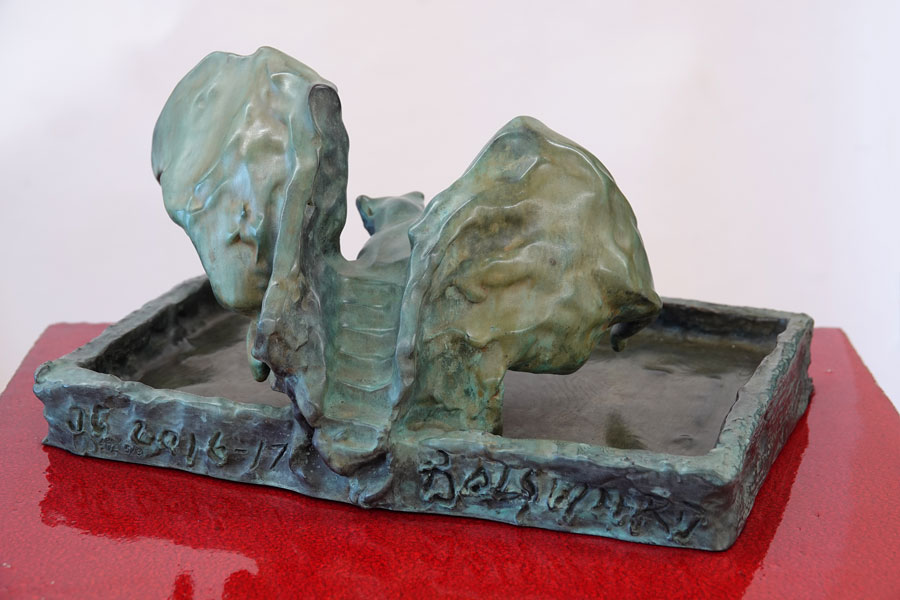
Price on request
Deze brons is de maquette voor de fontein van Johan Creten in Bolsward. Klik hier voor de openingspeech van Johan Creten op 18 mei 2018
Le Baiser, 2013, ed 1/1 from ed of 3 + 1 AP
Patinated bronze, lost wax technique, signed, dated, eagle & foundry stamp
211 x 49 x 46 cm, 262 kg - price on request

Fireworks | Exit West | 2018

Fireworks | Exit West, 2018, goldluster on majolica glazes and stoneware, 104 x 77 x 20 cm, price available on request
La Communauté | De Gemeenschap | 2010

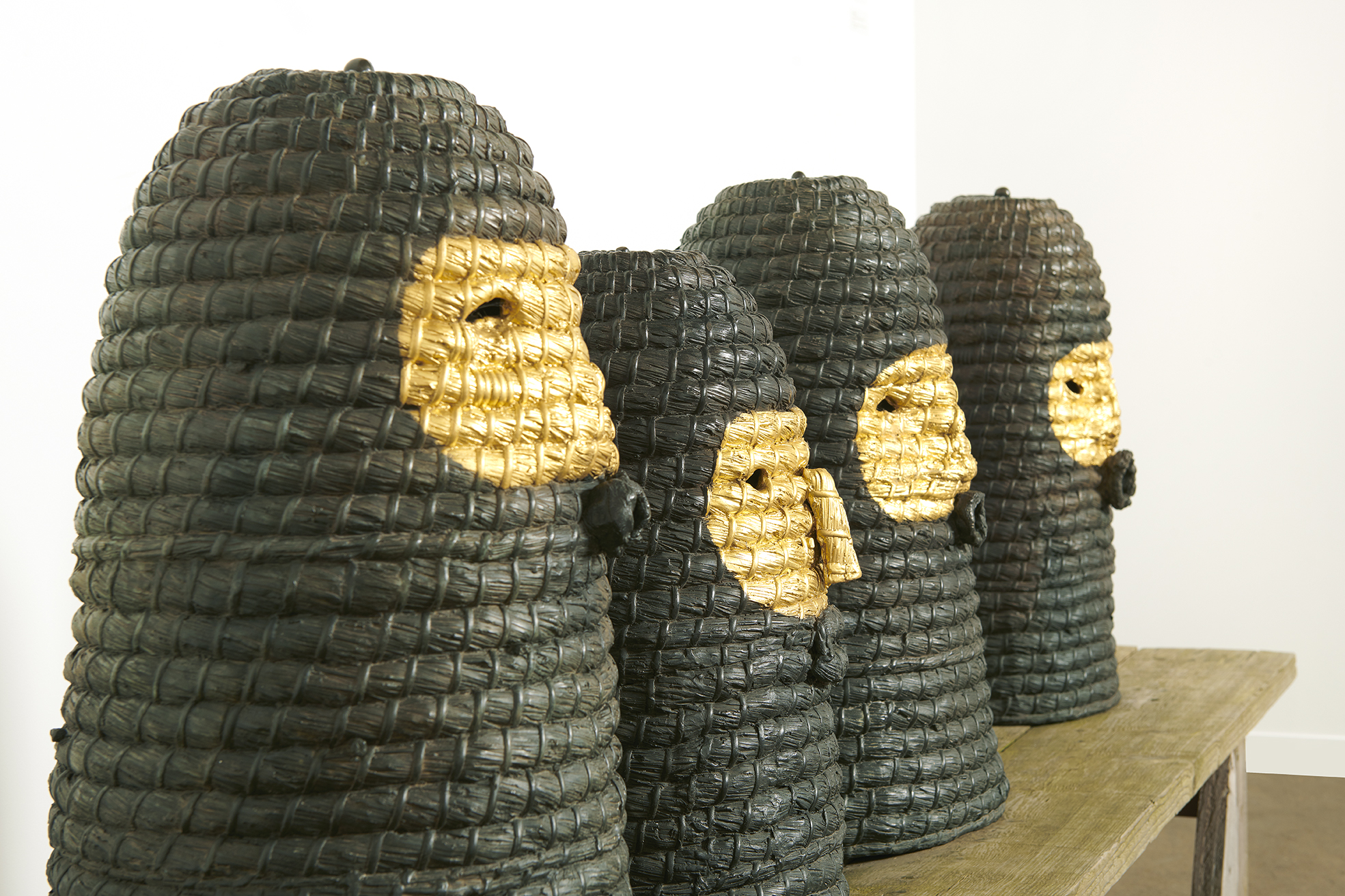
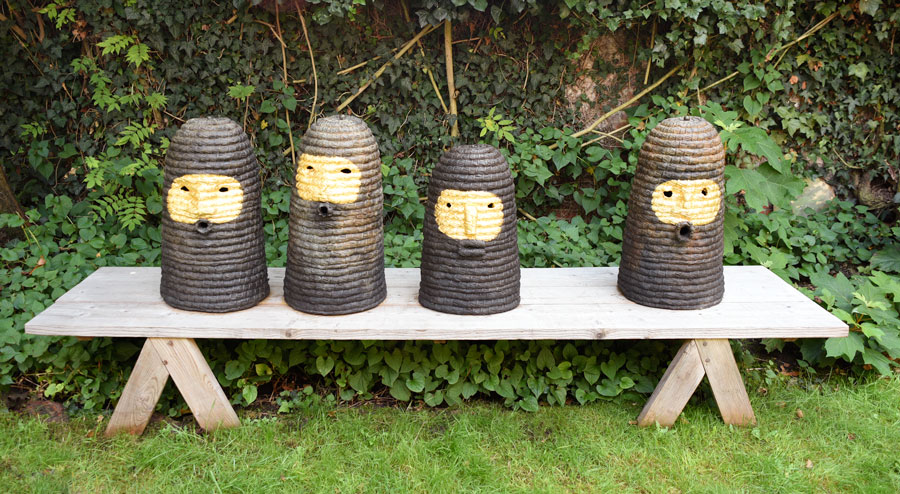
La Communaute, 2010, guilded bronze, 116 x 260 x 60 cm, price available on request
Blue Orchid | 2015
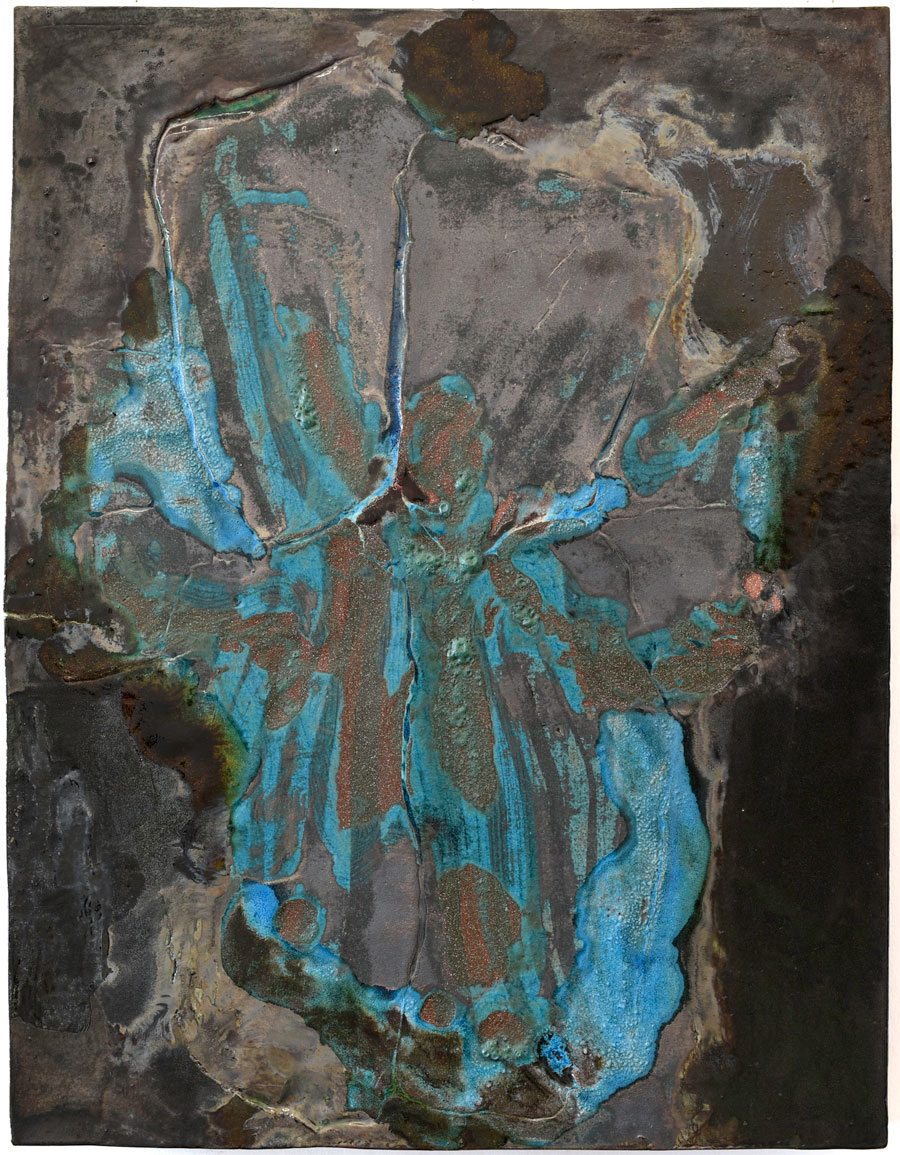
Blue Orchid, 2015, glazed stoneware, 95 x 66 x 11 cm, price on request
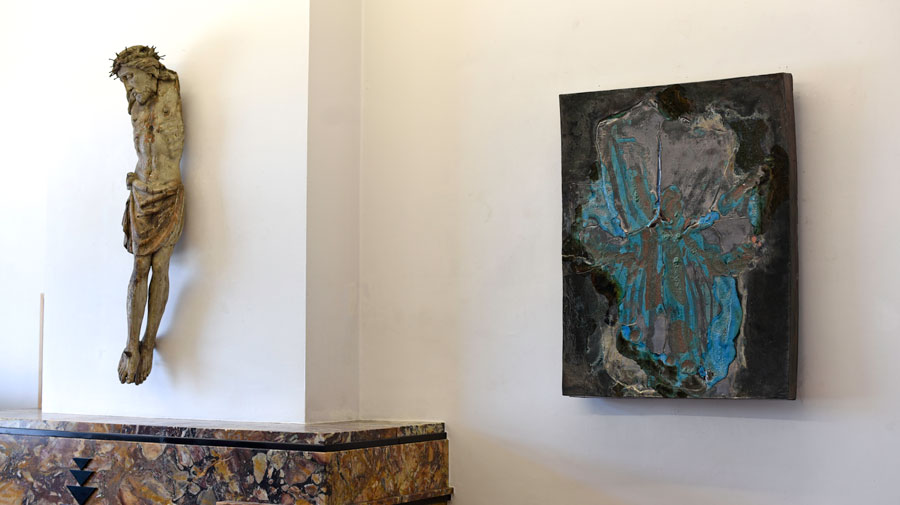
Blue Orchid is on view at the gallery, with 15th century Christ
De Gier | 2016
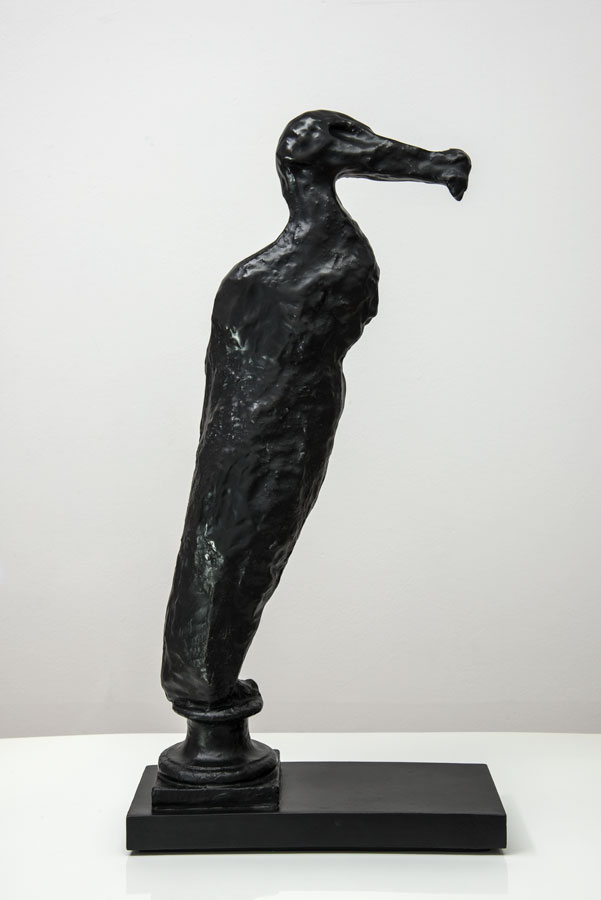
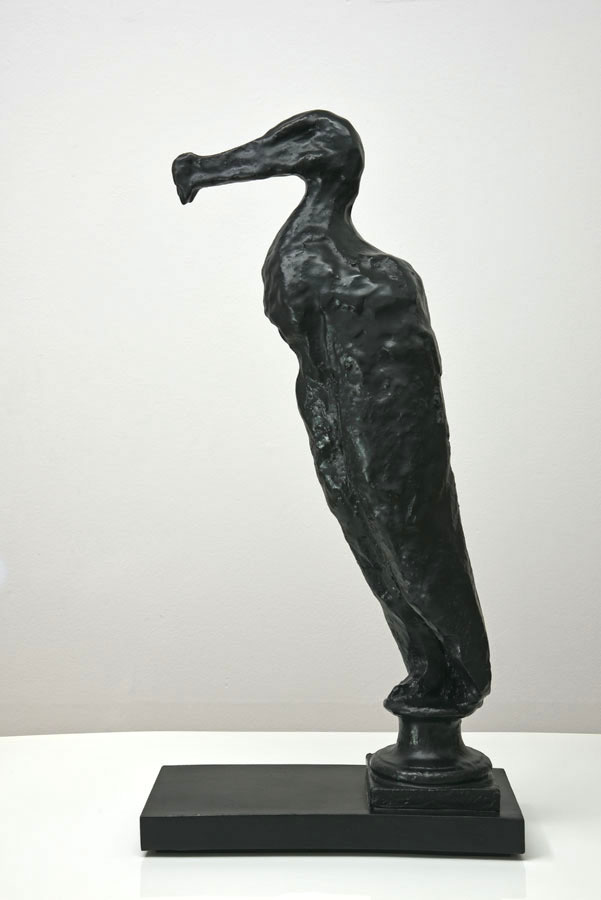
De Gier, 2016, bronze, black patina, 64 x 32 x 15 cm
ed 8
+ 2 ea, only one left: ed 8/8
Pliny's Sorrow | 2010
Click here for a complete file about the monumental version of this work
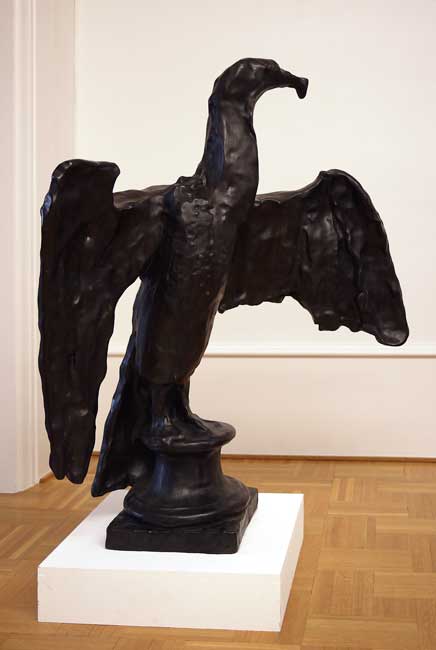
Pliny's Sorrow, 2010, bronze, ed 1/3, 108 x 102 x 45 cm, price on request
... Pliny the Younger:
If having the pictures of the departed placed in our homes lightens sorrow, how much more those public representations of them which are not only memorials of their air and countenance, but of their glory and honour besides!
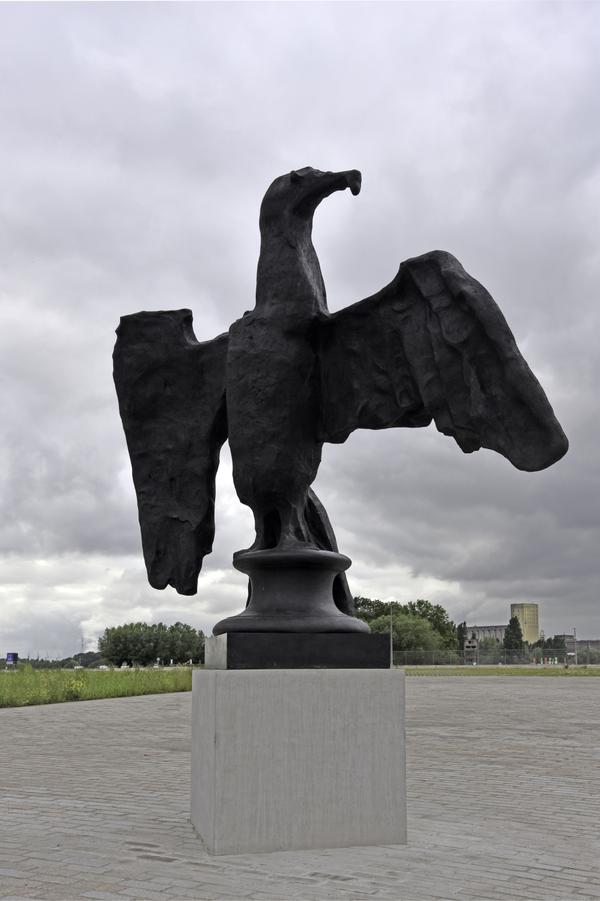 |
Pliny’s Sorrow, in een monumentale versie kreeg dit beeld van Johan Creten een definitieve plek aan het Red Star Line Museum aan de Rijnkaai in Antwerpen. Zie ook deze video: https://www.youtube.com/watch?v=vwizl3c48Xw |
Octo Table III | 2013
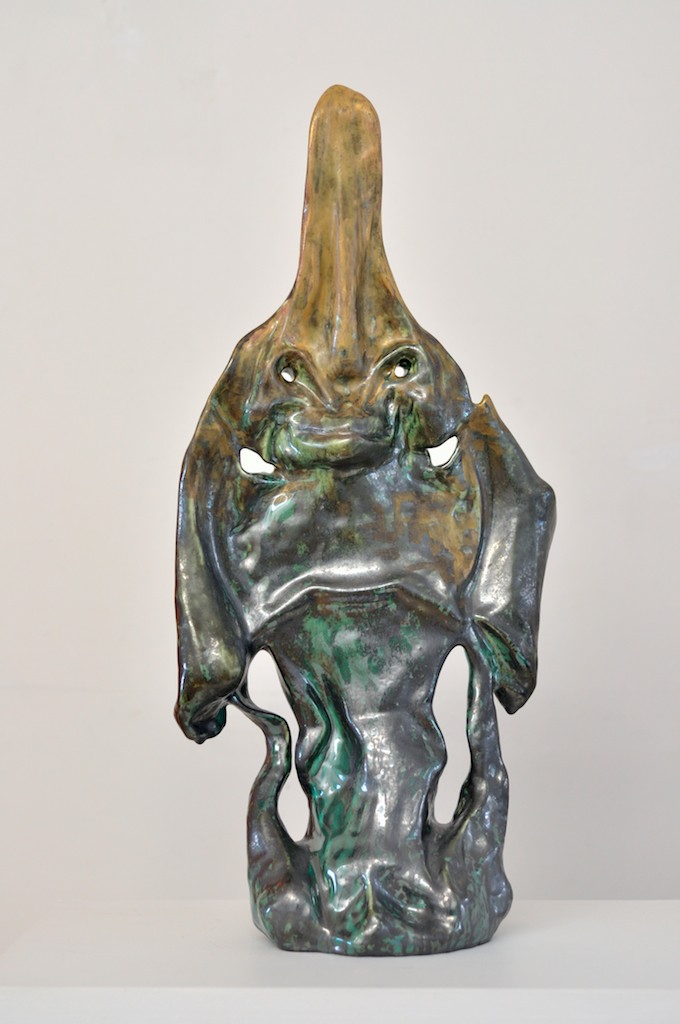
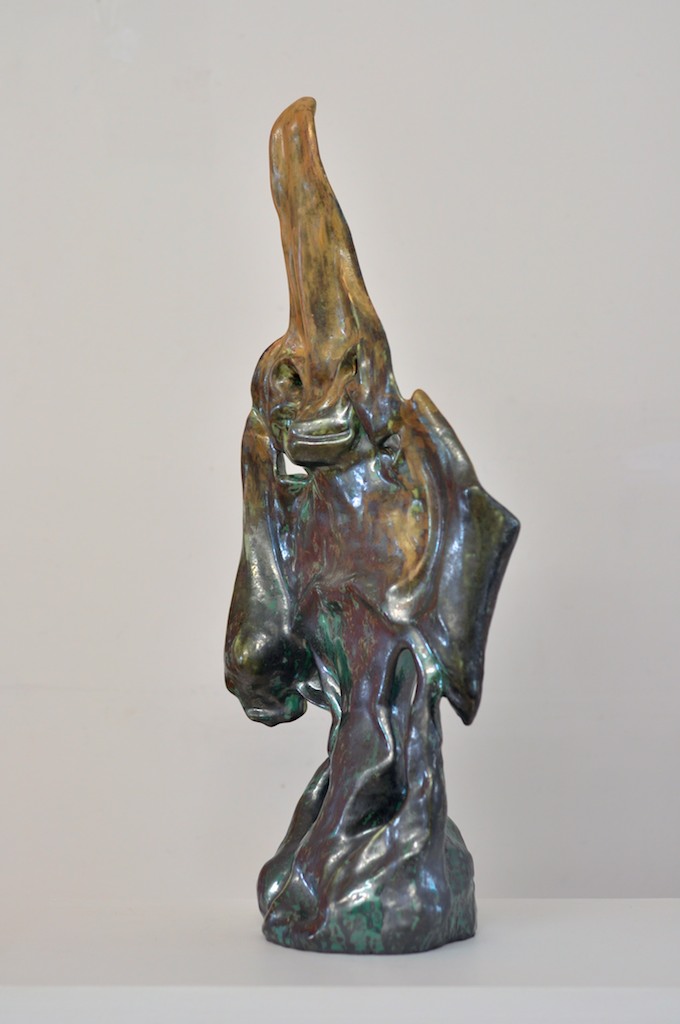
Octo Table III, 2013, glazed stoneware, unique, 65 x 32 x 16 cm, price on request
Click here to see more: Octo Table III & Octo Table IV, and detail photographs
Torch | 2010
'Toorts | Torch', 2010, glazed stoneware, unique, 132 x 60 x 48 cm, price on request
Wasps | 2002
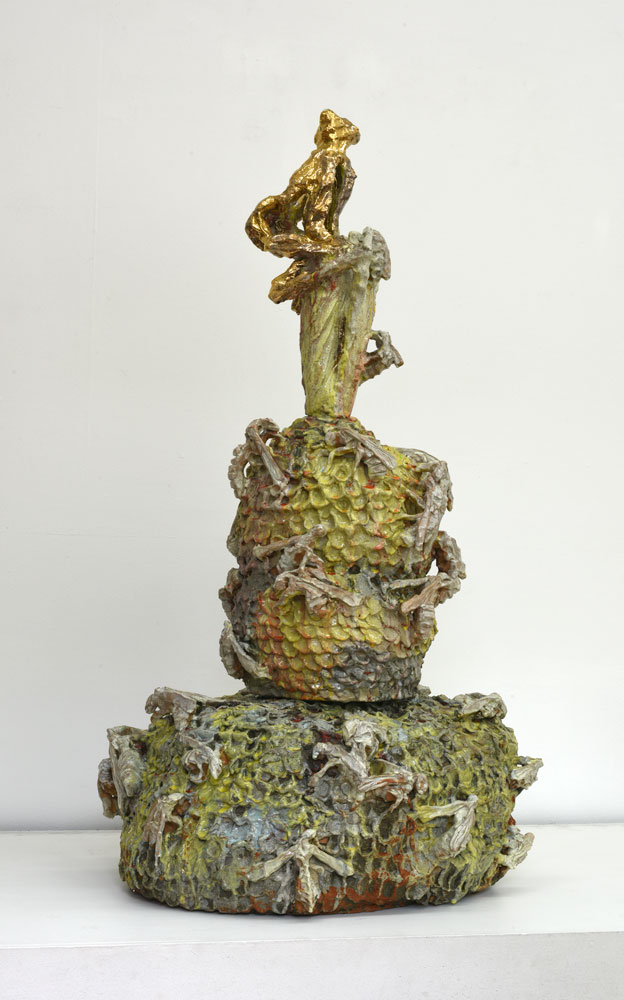
Wasps, 2002, glazed stoneware, 125 x 69 x 63 cm, price on request
And some details:
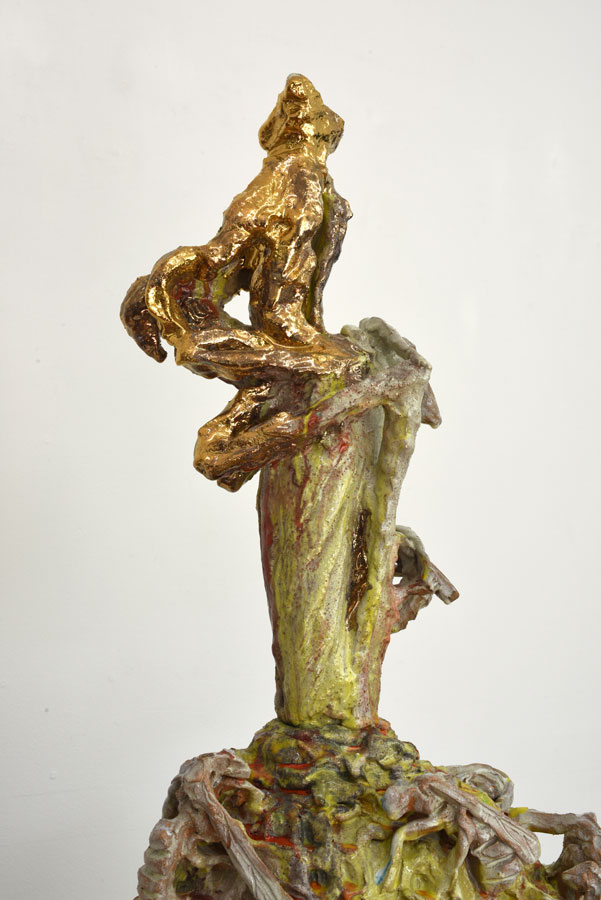
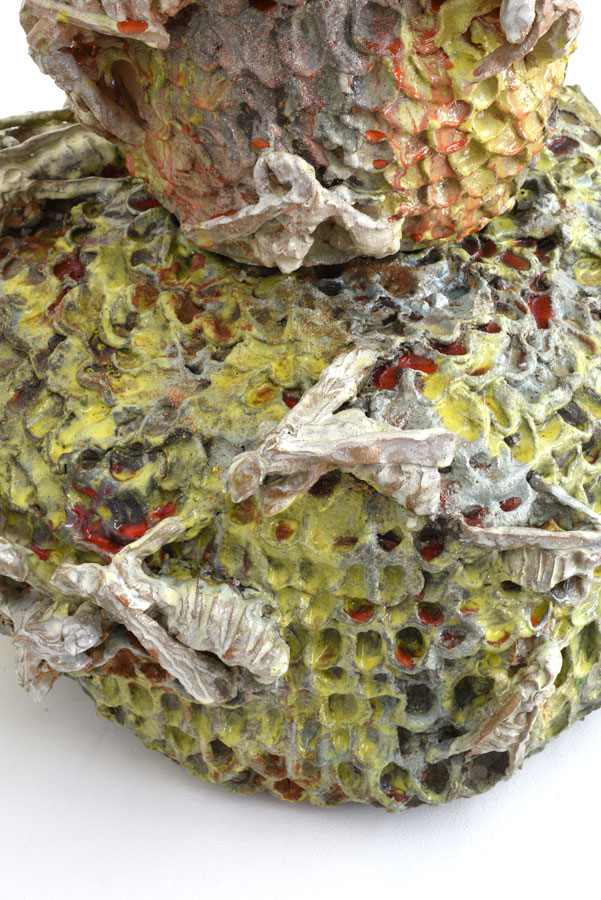
De Hanen | 1994

De Hanen | Les Coqs, 1994, email in baked clay, unique, 112 x 107 x 51 cm, price on request
Bi-Boy Black | 2015
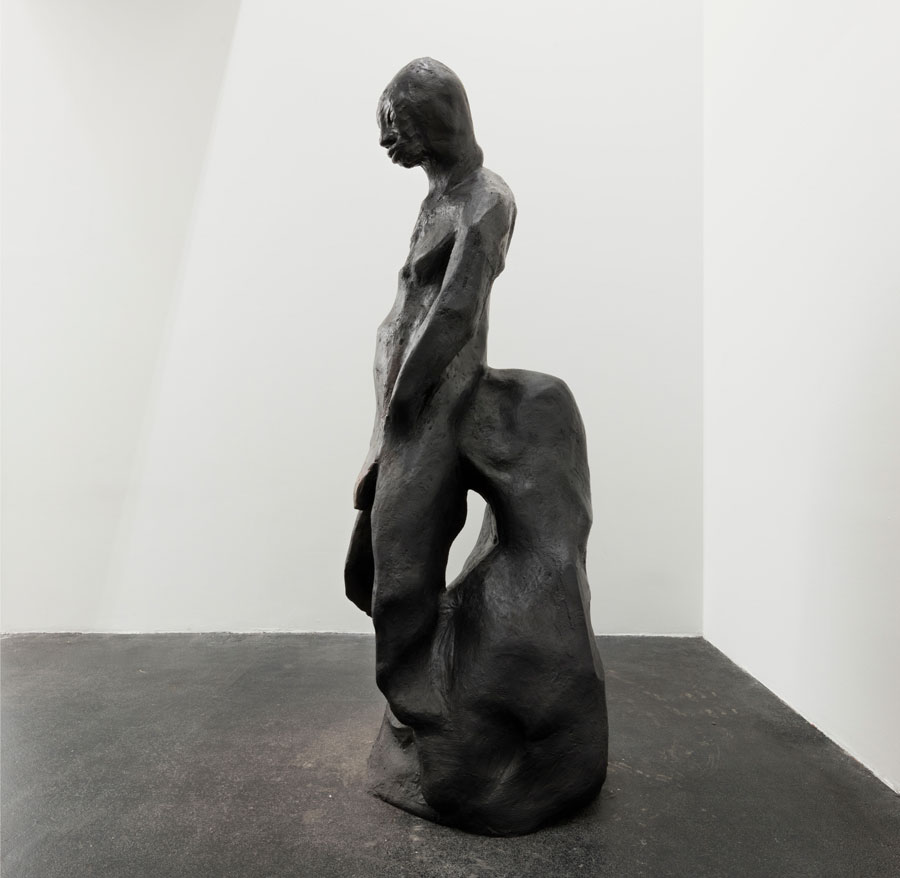
Bi-Boy Black, 2015/2016, patinated bronze, lost-wax casting, 230 x 100 x 80 cm, ed 1/5, price on request
Le Grand Vivisecteur | 2014

Le Grand Vivisecteur, 2014-2016, unique model in polyester for bronze sculpture, 300 x 148 x 137 cm, price on request
Johan Creten, Le Grand Vivisecteur, permanente installatie aan Sint-Romboutskathedraal te Mechelen
klik hier voor meer informatie over het beeld
kijk hier voor 5 minuten videoreportage, met commentaar van de kunstenaar en de schepen van cultuur Björn Siffer
Click here for the version with english subtitles,
